30 October 2023
![]() 31 mins Read
31 mins Read
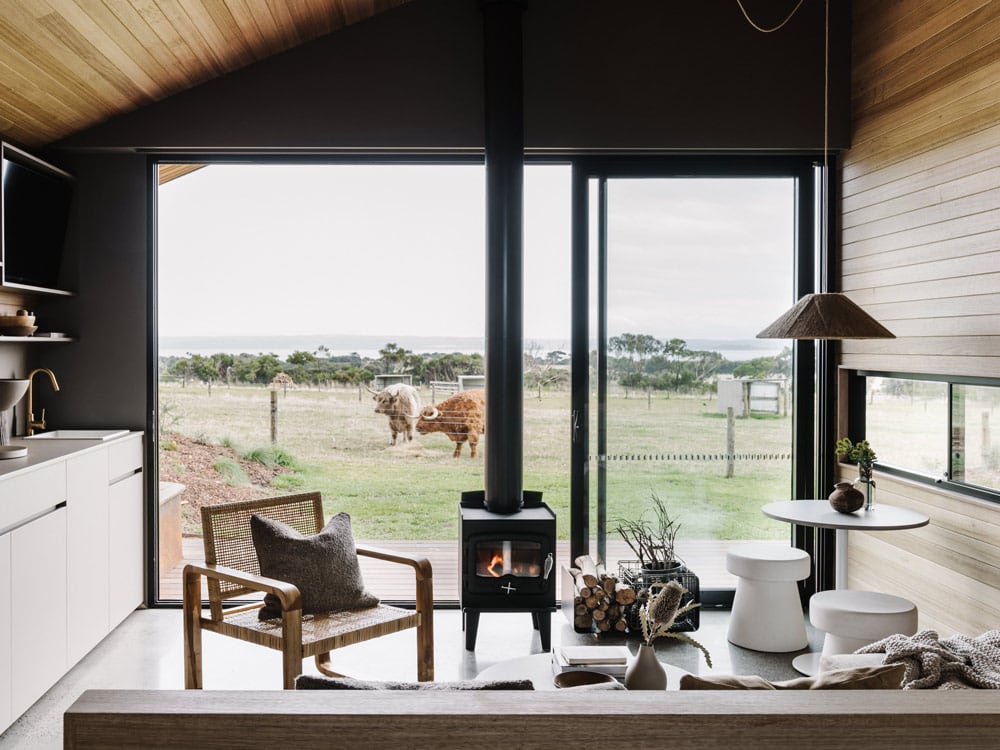
We’ve revealed our pick of 100 unique stays across Australia and below you’ll find the 15 unique stays in Victoria that made it into our coveted list. Head here to read the full list and start planning your next escape.
Ever since I read The Secret Garden I’ve been drawn to whimsical gardens. If walking through a rambling, flower-filled garden is an antidote to modern ills, then staying in an old garden shed is tantamount to a course of therapy. Located in the small town of Trentham, 20 minutes east of Daylesford, the Potting Shed is a self-contained, garden-themed studio retreat on a quaint rose farm. Upon arrival I can see how much love the owners have put into this special place. What was once a working garden shed is now a cosy adults-only (but dog-friendly) retreat that honours its horticultural heritage.
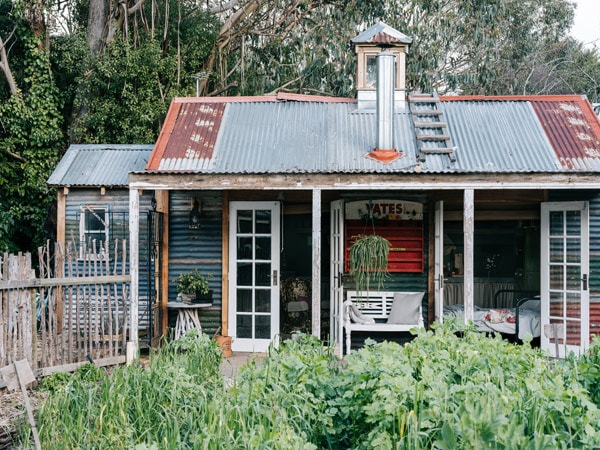
The whimsical gardens outside The Potting Shed at Acre of Roses in Trentham, Victoria.
Outside there’s a Yates display case and a productive kitchen garden. Beyond the fence there’s an acre of roses to explore, but it’s raining so I head inside as the drops beat down on the tin roof. Inside, I’m greeted by a wistful collection of vintage ephemera – still-life paintings, timeworn botanical books and retro wing-back chairs. Above, there’s a glass belltower with a bell just asking to be rung by the ropes draped over the timber beams. With a potbelly fire, fast wi-fi, commercial coffee machine, convection microwave, and fridge filled with gourmet bites, there’s no reason to leave. By night, I trade the soft embrace of the armchair for a deep slumber in a toasty bed warmed by an electric blanket.
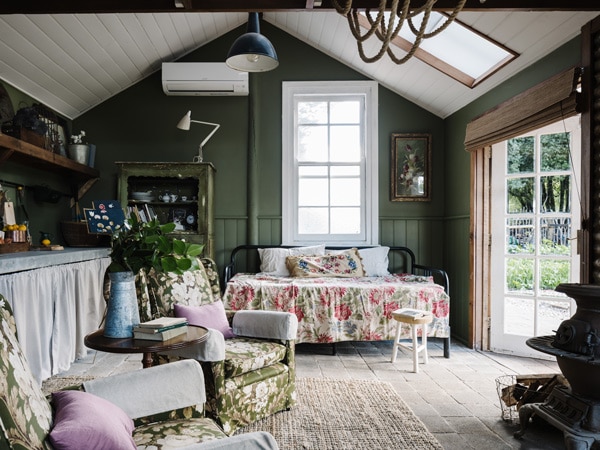
A look inside the quaint, idyllic accommodation at The Potting Shed. (Image: Marnie Hawson)
After a lingering lie-in, I graze on a complimentary continental breakfast of strawberries, muesli, yoghurt, juice, and sourdough from local artisan bakehouse RedBeard Bakery. Checking out, I realise I’ve accomplished nothing but reading, sleeping, eating, and listening to birdsong – and that’s fine by me. – Jo Stewart
“We get the three K’s here: koalas, kangaroos and kookaburras,” says Vanessa, host of Ardingly Tiny House, a small slice of serenity in Victoria’s Macedon Ranges. From Melbourne, it takes only an hour on the highway to reach the township of Newham, yet it’s far enough for my phone signal to drop out and billboards to give way to gum trees and farm gates. Belonging to the Tiny Away network, Ardingly Tiny House is one of many properties offering low-impact stays in rural areas. I’m staying for a much-needed circuit-breaker. Following the hand-drawn signs down the driveway I find my host, Vanessa, who shows me around the two-hectare property she shares with her husband, son and mini-menagerie of animals, including guinea fowl, ducks and two goats (Rasputin and Zanadu with a z) that live in a shed made from reclaimed materials.

Enjoy a cosy stay in Victoria’s Newham.
The term ‘eco-friendly’ gets bandied around a lot, but this place is the real deal. It’s solar powered, wood heated, and the compact bathroom has a composting toilet. With no wi-fi and patchy phone coverage, I start the fire, then settle in with a book and a beer. After preparing a basic dinner in the kitchen that fits everything I need into a remarkably small space, I climb the ladder leading to the loft bed and lie there drinking in the silence and darkness. In the morning, my breakfast is an apple from one of the property’s trees – a small, simple pleasure, just like my stay at Ardingly Tiny House. – Jo Stewart
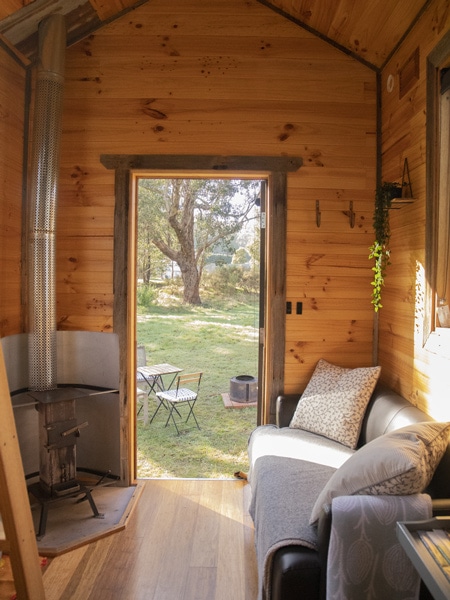
Live simply yet comfortably at Ardingly Tiny Homes.
The door swung open and my heart sank. It was picture perfect. You could shoot a romantic movie here; perhaps a remake of Same Time, Next Year where a couple reunite every year to rekindle their affair. The movie takes place in a single hotel suite, but this would be a far more compelling setting. If only I wasn’t here completely alone.
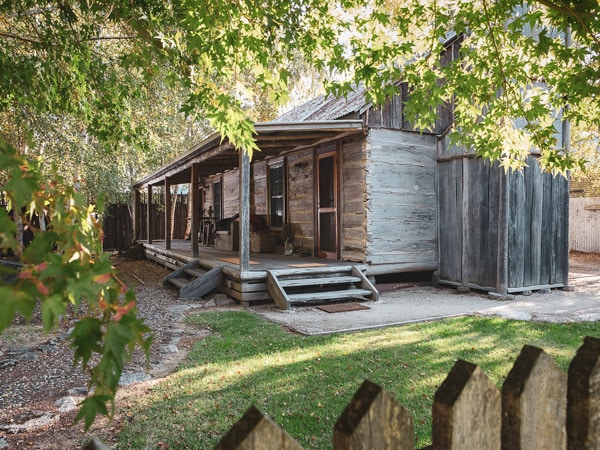
Be transported back to the 1860’s with a luxurious stay at 1860 in Beechworth.
The deep chocolate sofa in front of a stone fireplace is designed for optimal snuggling. The full kitchen is a short slipper-shuffle away. Meanwhile the one bedroom is so cosy it is like being enveloped in the arms of a giant teddy bear. And there’s a bathtub so deep you can sit straight and still have the water come up under your chin. And what makes this intimate haven so alluring is the bare timber walls. Not dark overbearing panelling, but real Australian bush timber.
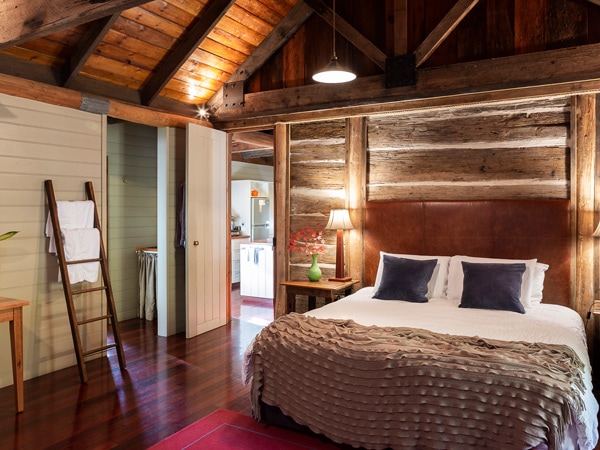
The 1860 cottage has all the essentials for a romantic getaway.
The cottage was built in 1860 (hence the name) from local timbers and is the quintessential highland hut. The structure was dismantled piece by piece and then reassembled with every piece being restored back to its original place. Clancy could have built and lived in this refuge, although he would never have gone droving if it was as sumptuous as it is today. So, there’s no romance during my stay, but I do make the most of the ‘me time’. Same time, next year perhaps. – Quentin Long
When I get swept away in fantasies of owning a pocket-sized hideaway in the country, Five Acres’ cabins are what I envisage. A rural retreat that feels light years from civilisation – but is, in fact, less than a 10-minute drive from the town of Cowes – it’s the kind of dreamy, design-led den that you could hole up in for days without developing the slightest thirst to leave.
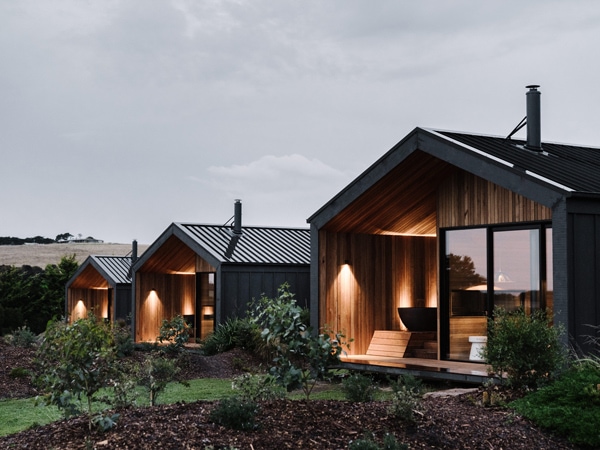
The beautifully modern and coastal architecture of Five Acres. (Image: Marnie Hawson)
Small in dimension, yet big on thoughtful features, Five Acres’ three minimalist cabins gently persuade guests to go analogue. A slimline, standalone wood-burning fire takes centre stage in the lounge, already made up with kindling and newspaper, ready to be lit. A carefully curated selection of cookbooks, poetry paperbacks, tomes on sustainable living and independent magazines dot the cabin’s many nooks, and are all perfectly aligned with the pace of life here, like Grounded: A Companion for Slow Living and The Farm Community: Grow. Cook . Share. Connect. And with floor-to-ceiling windows that look squarely onto the property’s paddocks, replete with shaggy coated Highland cows and sheep scratching themselves on fence posts, a sliver of Western Port Bay on the horizon, who needs a TV anyway?
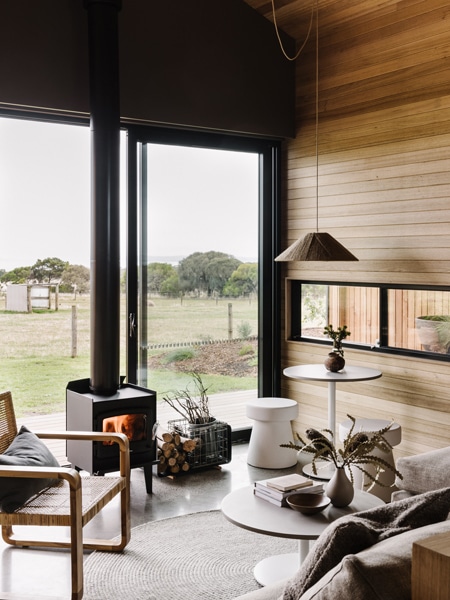
Escape by the sea at Five Acres. (Image: Marnie Hawson)
That’s not to say every trace of technology has been removed: USB ports sit next to each bedside, the one-wall kitchenette is full of Smeg appliances, the lime-washed bathroom features underfloor heating, there’s a Bang & Olufsen bluetooth speaker in the lounge, and a TV preloaded with Netflix is secreted smartly away on the kitchen wall. But on a bleak winter’s night we’re happily bathing in a sea of old-school entertainment. As we pore over the books under the weight of a chunky knit blanket, the fire crackles, the blustery sea wind puffs at the windows and doors, and ice tinkles in our glasses of G&T, made with gin from local Gippsland distillery Loch’s – just one of the thoughtful provisions that’s included in our stay. And, should the urge to eat gelato strike at an ungodly hour, fear not: there’s a whole tub from an independent island gelateria ready and waiting to go in the freezer; just use the direct deposit details given on the countertop, transfer $15, and dig in. Come breakfast, the spread in our pantry offers an equal serve of hygge: freshly ground coffee, gloriously coconutty homemade granola, natural yoghurt, Gippsland Jersey milk and butter, sourdough, jam made with rhubarb plucked from the working micro-farm’s garden.

Spoil yourself with the delightful food at Five Acres. (Image: Marnie Hawson)
The grounds on which Five Acres sits are home to some 90 fruit and nut trees plus extensive veggie gardens. And in time, owners Katie and Rom Lamaro hope to use their five-acre (two-hectare) block to provide produce for the local community as well as their own family. Almost every part of their venture has been built from the ground up by the couple. Rom constructed the cabins with his brother Christian, who owns a building company. And even some of the furniture within them – such as the bed frame made from Tasmanian oak – was handcrafted by Rom himself. Doused in natural materials and featuring a riot of textures and angles, the cabin interiors look as if they were pages torn straight from the latest issue of Architectural Digest. Almost every conceivable surface is clad with beautiful blond wood.
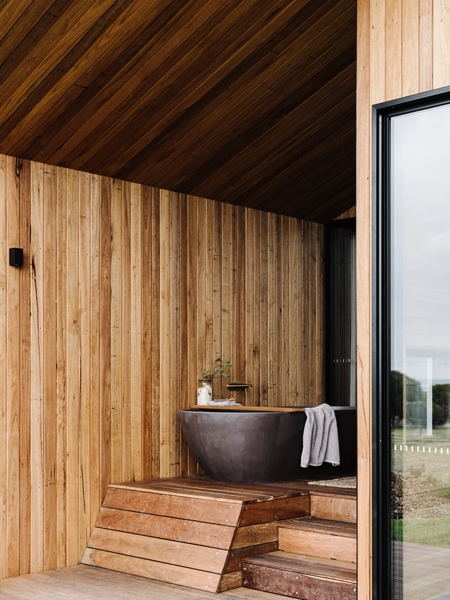
Wash off the sea salt with a warm bath. (Image: Marnie Hawson)
A freestanding smoky grey concrete bathtub stands on the sheltered deck outside the bathroom’s sliding doors, hidden in plain sight behind gauzy sand-coloured linen curtains. And light pours in through the skylight cut into the roof over the rain shower head. There’s a toughness to the design and furnishings that reflects farm life, but an inviting cosiness, too. A destination that’s long been popular with young families, Phillip Island wears many eclectic hats. It also carries a legacy of nostalgic seaside getaway that skews a touch brash, rather than a chic weekender for Melburnians with a surfeit of disposable income. But Five Acres could be at the crest of a new wave that’s slowly washing ashore. Over the last five years, a handful of sea-changers just like Katie and Rom have set up shop on the island, opening a craft taphouse here, a third-wave coffee shop there, and an industrial-chic cafe or two. Phillip Island may not have the cachet of neighbouring Mornington or the Bellarine Peninsula, and perhaps it never will; but for some, its emerging alter ego will prove the perfect counterbalance. – Chloe Cann
When is a dairy shed not a dairy shed? When it is a luxe farmhouse stay packed with interestingly quirky features. Here, we explore The Silo House with its owner Belinda Scott.
The site was the location of my husband Allister’s family’s original farmhouse that burnt down when a share farmer was living in it four years ago. It backs onto the family dairy farm and, as three generations have lived on the farm, it has great sentimental value to everyone in the family. When deciding what to rebuild, Allister and I thought we should pay homage to the farming history, and our aim was for anyone driving past to think it was a dairy shed, not a residence. We had a lot of fun with it, trying to stay true to the farming shed look, but also creating amazing spaces of freedom and comfort.
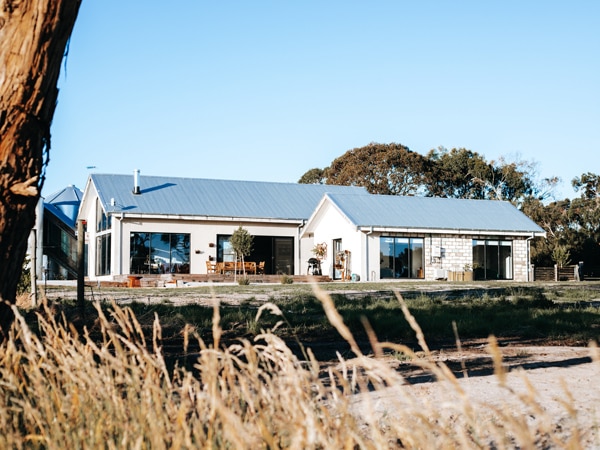
The Silo House Inverloch.
Make it look like an authentic dairy shed, but be very liveable, practical and exciting to explore.
Once inside, it has amazing spaces to gather, entertain, relax and escape the world in. There are also so many details in each room that you feel like you are constantly exploring, noticing and appreciating new things. The interiors are filled with some eclectic pieces, including old prison doors; what elements resonate with you? Definitely the history of the prison doors and the farming and agricultural touches such as the suspended cattle walkway on the second level. The view is pretty spectacular, too.
I describe myself as a bowerbird, collecting old treasure with a story to tell from all over. Many of our items came from local farmer David Wrench, of Outtrim, a big-time hoarder whom we visited regularly throughout the build to find either pieces that would fit the build or pieces that we made fit the build.
That it is so much more than a place to stay. It is an experience, an escape. Whether it’s sleeping in a round silo bedroom with a view across the farm and vineyard [which Allister planted with pinot noir vines], showering in a unique water-trough shower, or hiding away in the underground milking pit turned gin bar lounge [viewed through a glass panel in the floor of the living area], there is so much to do within the premises.
That they didn’t leave the house during their stay or want to leave after their week because they hadn’t had enough time to explore and enjoy everything.

The rustic interior of Silo House.
Victoria’s old goldfields towns and cities possess an atmosphere all of their own – all the ambition and folly of 19th-century prospectors wrapped up in a wrought-iron balcony. And, in recent years, an injection of hot new establishments bringing fresh ambition and spirit to the streets, while staying true to a sense of heritage, has seen something of a cultural renaissance sweep through.
The Provincial Hotel Ballarat embodies this: a boutique hotel opened in late 2018 in an iconic building on historic Lydiard Street that is listed by the National Trust for its expressive Art Nouveau facade, domed turrets and all. Inside is a stylish and serene space that, in true Ballarat style, takes design cues from contemporary trends while staying sympathetic to the building’s old bones. Each room is uniquely curated and our Lola Deluxe room shares its namesake with exotic dancer and actress Lola Montez, who caused a sensation when she visited the Goldfields in the 1850s. The tribute extends to Lola restaurant downstairs, but instead of dancing on tables and drenching dukes in soup, here we’re dining in playfully sophisticated surrounds with a European- inspired menu shaped by the best of locally sourced produce. – Imogen Eveson

Enjoy a truly boutique experience at The Provincial. (Image: Marcel Aucar)
Eco and glamping kind of go hand in hand, given the off-grid allures that the luxe version of camping offers. But Alkira Eco-Glamping Retreat in Victoria’s spectacular Dandenong Ranges relies on more than just close proximity to trees to own the much (over)-used distinction. Sitting on hosts Emily and Andrew’s 16-hectare property of farmland and thick eucalyptus bush just minutes from the town of Emerald, Alkira is a former open-air artist’s studio that has been converted by hand into a charmingly rustic straw-bale yurt.
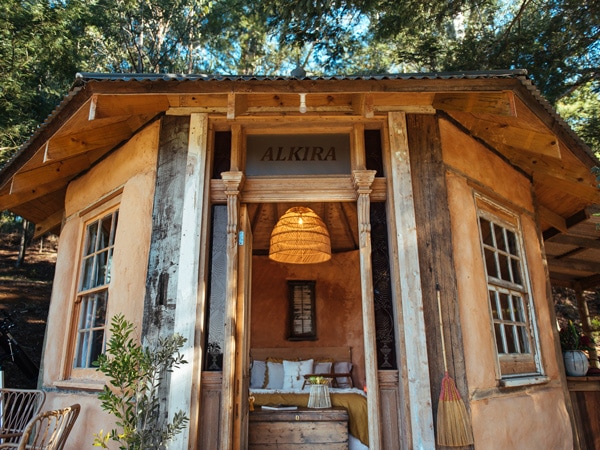
Experience an eco-friendly stay in the luxurious Alkira yurt. (Image: Jaccob McKay)
Decked out with boho-chic touches and a sunny palette of yellows and white, the details are delightful in their execution: from the generous bed, draped in fresh linen and positioned so you can look out through the leadlight-lined front door; to the cute table for two under the window where you can enjoy breakfast, made from ingredients left for you in the covered outdoor kitchenette (freshly baked bread and brewed coffee are staples); to the retro radio, games, books and magazines that will help while away the hours sitting outside shaded by mountain ash trees; to the outdoor fire pit beside which you can warm yourself as you sit under the stars. As for the bathroom, it sits a short walk from the yurt, housed in an impossibly cute corrugated iron and wood outhouse.

Alkira interior details. (Image: Jaccob McKay)
Its simple exterior hides its luxe inclusions including a rain shower, designer toiletries and a composting toilet. Once settled in, time can be spent exploring the farm itself, which is home to cows, horses, alpacas and ducks paddling in the creek and native wildlife and birds, and the surrounding area. There’s shopping to be had in the nearby village of Kallista, the Puffing Billy steam railway to transport you back to your childhood, and hikes and treks aplenty within the lush, green expanse of the Dandenong Ranges National Park. And, of course, you can always choose to do nothing at all: just like eco and glamping go hand in hand, relaxing and glamping are also very happy bedfellows.
With a coffee shop on every corner in neighbourhoods that invite you to become part of their fabric, Melbourne is the kind of city that makes you feel like a local within no time. And I love that feeling of familiarity I get from revisiting time and again. But I also love that it can surprise and reveal new sides to me, as it does when I check into United Places. This small and luxurious hotel is an urban oasis set on the edge of the city’s Royal Botanic Gardens in a village precinct I’ve never explored before.
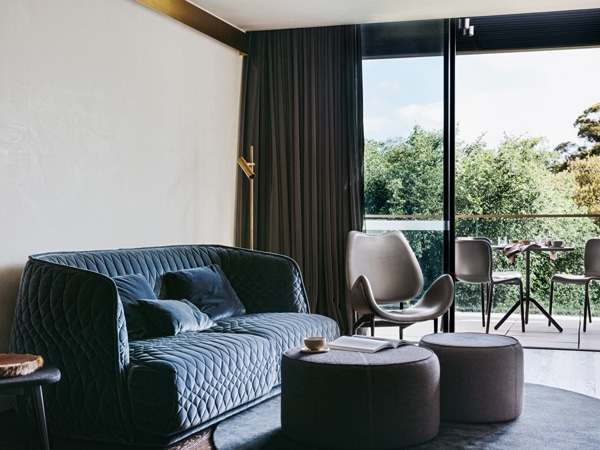
United Places is an urban oasis set on the edge of the city’s Royal Botanic Gardens. (Image: Emily Weaving)
Inspired by the minimalist aesthetic of Brutalism and anchored by sandblasted concrete and bronze trim, this most contemporary of hotels cuts a sleek profile on Domain Road in contrast to the elegant Art Deco architecture of surrounding South Yarra and leafy aspect of the botanic gardens. Inside my garden suite – where the sunny terrace overlooks those parklands – the clean lines are offset by rich materials and soft furnishings such as the sumptuous velvet drapes that cocoon my sleeping quarters at night with the light touch of a button; cleverly integrated tech, such as this motorised curtain track, elevate United Places to another level. A concierge who delivers a platter of fresh fruit and pastries as I’m settling in, Le Labo Santal 33 amenities and artisanal additions made in collaboration with local and likeminded companies (coffee pods courtesy of ST. ALi and organic Loom towels and textiles) up the ante even more. So it’s a hard call to tear myself away.
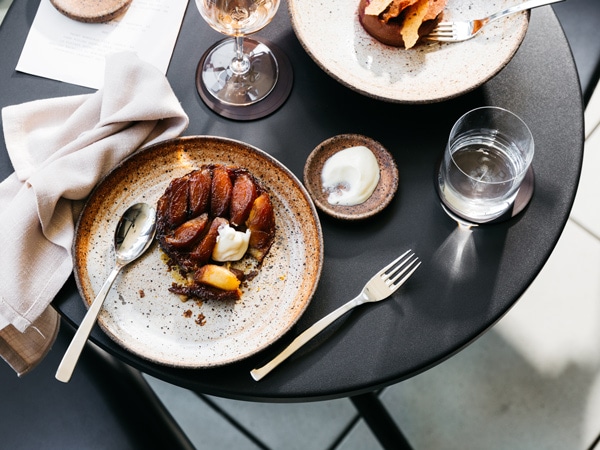
Dine downstairs at Matilda 159, the hatted destination diner from Melbourne chef-restaurateur extraordinaire Scott Pickett. (Image: Emily Weaving)
Matilda 159, the hatted destination diner from Melbourne chef-restaurateur extraordinaire Scott Pickett that’s located just downstairs, is a good start (although you can also order room service from here). As is the private guided forest therapy session through the botanic gardens, part of the hotel’s Reboot Package, which I soon find myself embracing: an exercise in mindfulness in the outdoors. After that I meander along the river to the nearby NGV International to see a different side of the city again. Flanked by the gardens on one side and the Yarra backed by the city skyline on the other, alongside the joggers and the dog walkers and the amblers like me, I feel positively local again. – Imogen Eveson
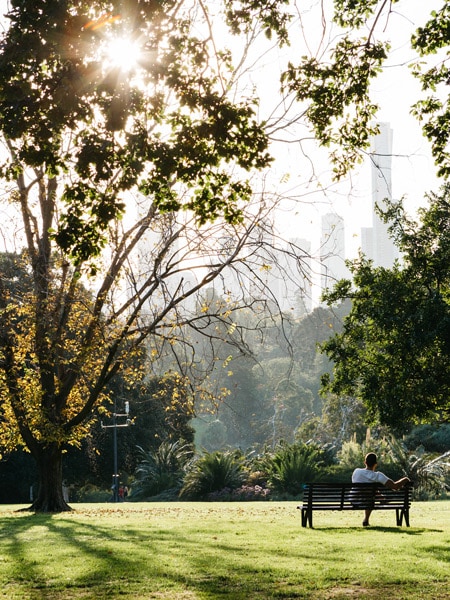
Take advantage of the hotel’s private guided forest therapy session through the botanic gardens. (Image: Emily Weaving)
Fitzroy is Melbourne’s oldest suburb, an inner-northern enclave known for its authentic creativity expressed through an eclectic mix of bars, restaurants, cafes, studios and art galleries. Set in a quintessential bluestone in a leafy backstreet, espresso and wine bar Napier Quarter embodies this spirit and more with its commitment to quality, celebrating community and championing the artisan. Which sets the tone for its adjoining guesthouse, too, opened in March 2020. “I had always loved the idea of extending the usual offering of a restaurant or bar into accommodation,” says co-owner Daniel T Lewis. “At Napier Quarter we believe it’s not just food, wine or service that creates a memorable experience but the nuanced combination of all that provides you with a feeling. That feeling you can’t really describe, but entails the convivial nature of the room, a connection, your ‘place’, a belonging. Home.”
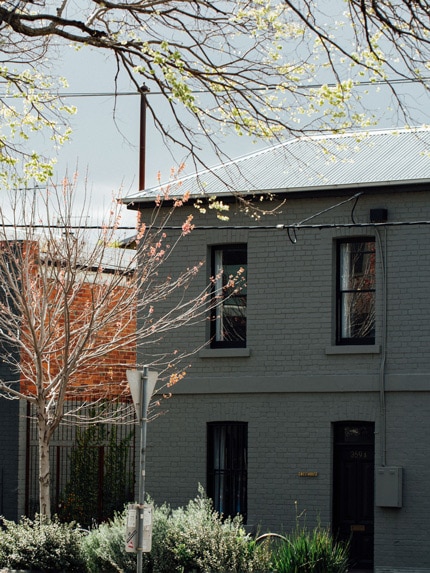
Napier Quarter is an espresso, wine bar and guesthouse in one. (Image: Annika Kafcaloudis)
The guesthouse is the artistically stylish Melbourne home you wish was yours: a luxuriously spartan aesthetic and moody tonal colour palette; local ceramics in the kitchen; handmade linens in the restful bedroom; Japanese cotton towels and Aesop in the bathroom. Every item has been chosen thoughtfully. Styling the space was very personal, not forced, says Daniel. “I love the layers of history of the building from the bluestone foundations to the ’70s terracotta tiles. The arched dining room entrance to the ornate ceiling rose. All reminders of the previous lives and so deeply Fitzroy. I especially adore the female nude oil paintings by New York artist Elizabeth Widmayer, Stella and Vivienne, sourced from a wonderful vintage store in country Victoria. They adorn the walls with stories of their own.”

The guesthouse is the artistically stylish Melbourne home you wish was yours. (Image: Kristoffer Paulsen)
It’s all about the rituals here at Napier Quarter. A welcome glass of wine with your house tour on arrival. A digestif to sip late-night in the sitting room overlooking tree-lined Napier Street and the bustle of the bar below. A baguette and newspaper delivered in the morning to savour alongside provisions of jams, hand-churned butter and French-press coffee.
“We believe rituals are the foundations to a good life,” says Daniel. “Punctuating your day with simple pleasures should be encouraged, celebrated and never compromised. Our service style in the wine bar consists of a beginning, middle and end; we wanted to ensure that service crossed over into the guesthouse experience through morning to moonlight.
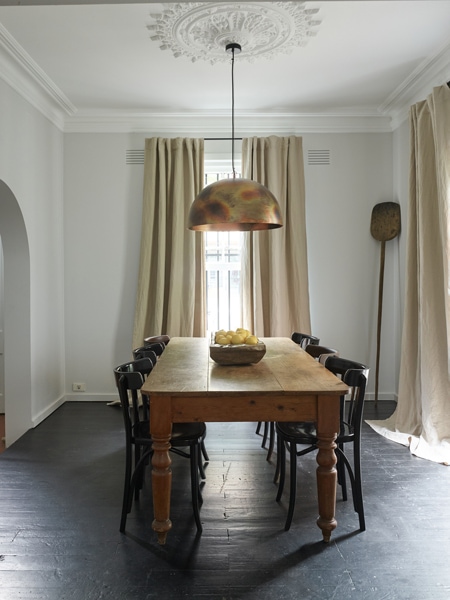
Find a sense of belonging at Napier Quarter. (Image: Kristoffer Paulsen)
“When I travel, I always like to stay in one area, in one space, for as long as possible,” continues Daniel. “I love the notion of being a local. To explore the layers of the neighbourhood. To feel the surroundings. I believe the place you stay should reflect the area and be just as important a component to travelling, if not the most. I also love having a comfortable place to go back to, with the simple luxuries you have at home. The first thing I do when I arrive at an Airbnb, guesthouse or hotel is unpack. Is there any better feeling than feeling at home, somewhere else?”
Sitting within the impressive 80 Collins precinct, Next Hotel is definitely the sum of its parts, creating a typically Melbourne experience through food and design. The rooms and suites (there are 255 in all) are resplendent in muted neutrals, tactile materials including wood, leather and marble and suitably moody lighting, with well considered luxuries like Hunter Lab amenities and Dyson hairdryers in the sleek bathrooms and cocktail-making stations well stocked with local boutique spirits.
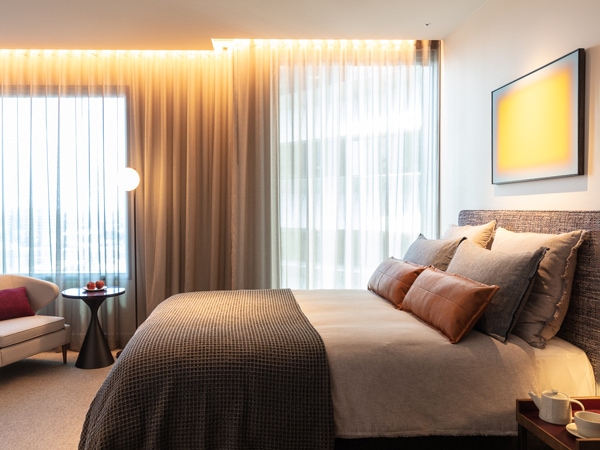
Next Hotel creates a typically Melbourne experience through food and design.
Similarly, the lobby space downstairs is also pleasingly sophisticated, with its swathes of marble and curvaceous wood, marble and brass central staircase. But it is the lifestyle created in between these spaces that stands out.
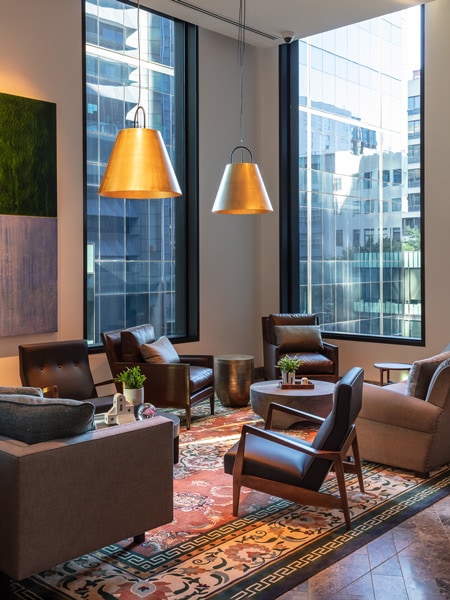
The lobby space of Next Hotel is pleasingly sophisticated.
La Madonna Restaurant & Bar is the hub of the property, executed to impress with big-deal local chefs Daniel Natoli and Adrian Li in charge of the menu and a wood-aging program for spirits and liqueurs on show in The Barrel Room.
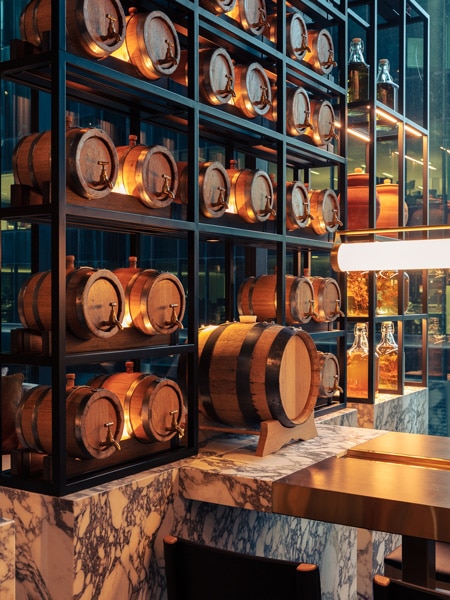
The wood-aging program for spirits and liqueurs is on show in The Barrel Room.
The restaurant is obviously geared to satiating the hotel’s guests, but its merits also draw in the city’s notoriously discerning diners, creating an atmosphere beyond the typical hotel restaurant.
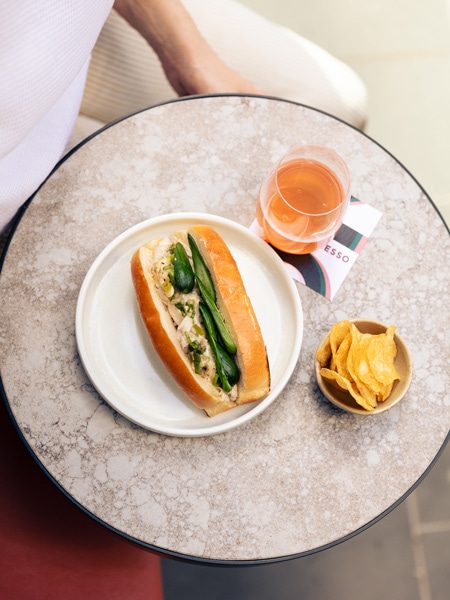
Ingresso is an understated yet stylish bolthole serving up espresso, lunch bites and evening cocktails.
Likewise Ingresso, located at the hotel’s discreet entrance on Little Collins Street, is an understated yet stylish bolthole that is also oh-so Melbourne, serving up the holy trinity of serious early-morning espresso, quality express lunch bites and early-evening Campari cocktails to a grateful local crowd.
Founded by artist Adrian Doyle in 2001, Blender Studios is one of the oldest independent art studios in Melbourne and has evolved in lockstep with the city’s urban art movement. Today it’s a hub of 22 artists’ studios working in street and fine art, has its own street-art-daubed laneway, and an adjoining gallery, Dark Horse Experiment.
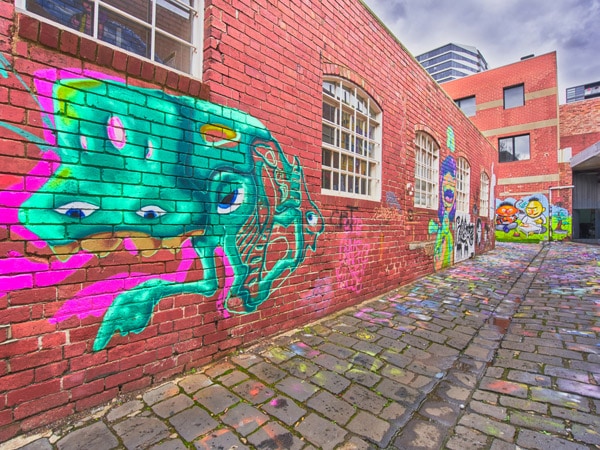
Blender Studios is one of the oldest independent art studios in Melbourne.
In 2019, the renowned complex added The Blender Loft to the mix. It was set up with Adrian’s partner and Blender co-director Piya Suksodsai, who brings her experience in the hotel and tourism industry to the table.
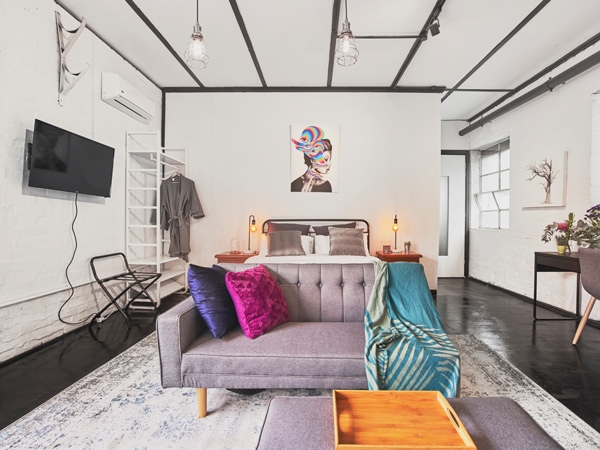
The Blender Loft was added to the complex in 2019.
An ‘Artbnb’, not an Airbnb, this unique urban stay is a way of bringing people into a creative space they might not get to experience otherwise. And, in a city known for its arts, staying at The Blender Loft is billed as the ultimate way to experience its vibrant culture. The self-contained studio is located above Blender Studios and Dark Horse Experiment in West Melbourne, a 10-minute walk across Flagstaff Gardens, the oldest park in the city, to Queen Victoria Market.
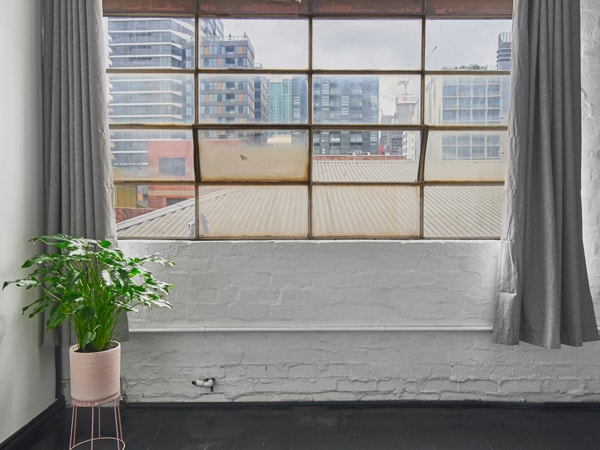
The self-contained studio boasts city views, original floorboards and bags of character.
With city views, original floorboards and bags of character, it is located on the mezzanine level of the old warehouse and oozes industrial charm. And, from the moment you set down your bags, arriving via a suitably mural-adorned stairwell, it is designed to be an immersive art experience. “It is a curated experience that is well thought out and quirky. The space is luxurious and spacious with all the things you need” – from yoga mat to body scrub – “to help make your Melbourne stay awesome,” says Adrian.
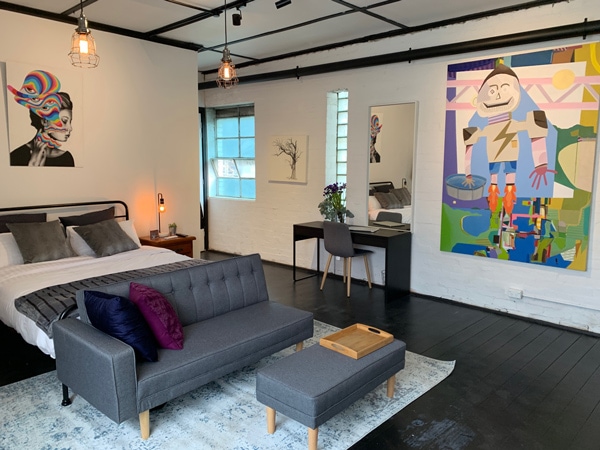
The Blender Loft oozes industrial charm.
A living and evolving art exhibition, the space is transformed every three months. It includes permanent works, like the Silent Concrete Television by Will Coles, but the rest is curated by Adrian with artists from the Blender Studios. “It is carefully thought out to make the whole space into an artwork,” he says. “It’s like you are staying in a wonderful artwork. And you walk down the stairs into a creative wonderland as each studio is filled with art.”
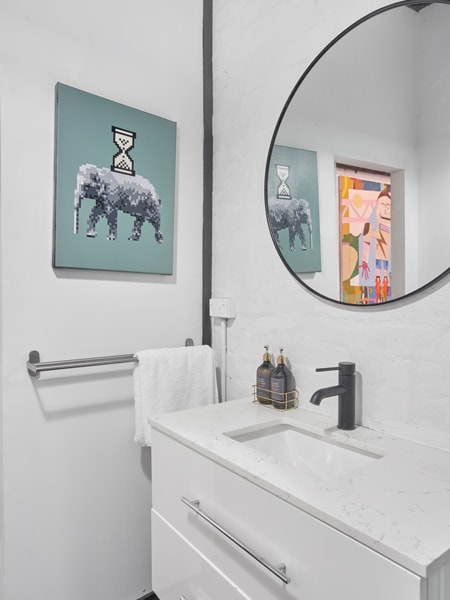
The space is a living and evolving art exhibition that s transformed every three months.
Guests at The Blender Loft are invited to enjoy all the action of the 24-hour art studios at their doorstep and are encouraged to meet the artists, get involved and be inspired. “When you stay at The Blender Loft, you never know what you are going to be part of as the Blender Studios has many events, exhibition openings, life drawing, workshops; every day is something new,” describes Adrian. “And if there is nothing on at the Blender, chances are there will be an opening nearby that all the artists are attending. Of course, guests will be informed of any cool event or exhibition that’s happening during their stay, and they are always made to feel welcome by the Blender artists in any context.”
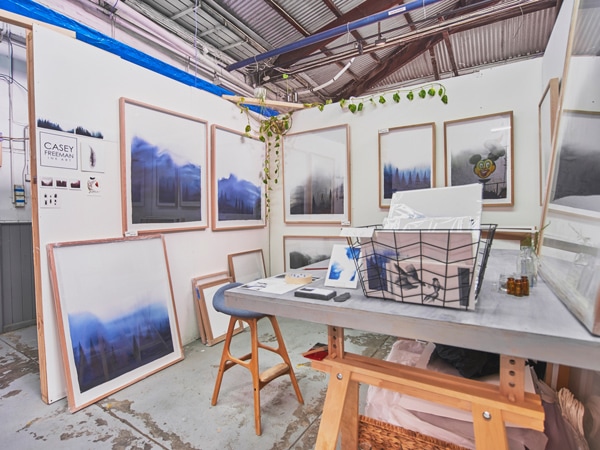
Guests at The Blender Loft are invited to enjoy all the action of the 24-hour art studios at their doorstep.
Blender Studios is also the HQ of Melbourne Street Tours, so you can head out from here on street art tours of the city as well as trying your hand at freehand and graffiti workshops. Adrian’s other tips for completing your creative Melbourne experience include checking out the National Gallery of Victoria, Australian Centre for Contemporary Art and the Victorian College of the Arts precinct; hanging out at Section 8 (the outdoor container bar that describes itself as ‘about as Melbourne as it gets’); or simply walking around Chinatown to find a late-night dumpling fix. “The Loft brings all kinds of people to the Blender and that’s important for the dynamics of the studios,” says Adrian of the overall experience. “The Blender Loft also helps to subsidise the rent of the artist’s space, so by staying at the Loft you are supporting Melbourne artists.”
With views like this, sometimes the most show-stopping design is all in the glass-to-wall ratio. You’ll find Sky Pods tucked along the Great Ocean Road at Cape Otway on the rugged Shipwreck Coast of south-west Victoria. Just over a decade ago, its owners Maxwell and Lisa, who had lived in inner-city Melbourne for all of their working lives, were seeking a change. With the environment at the forefront of their minds, they set about on a new project: purchasing a property with the intention of restoring the land to its pre-farming state. They would plant trees, establish a wildlife refuge and build a house run on solar and wind power. They happened on a property serendipitously – a magnificent but neglected cattle farm on Gadubanud Country – and saw its potential.
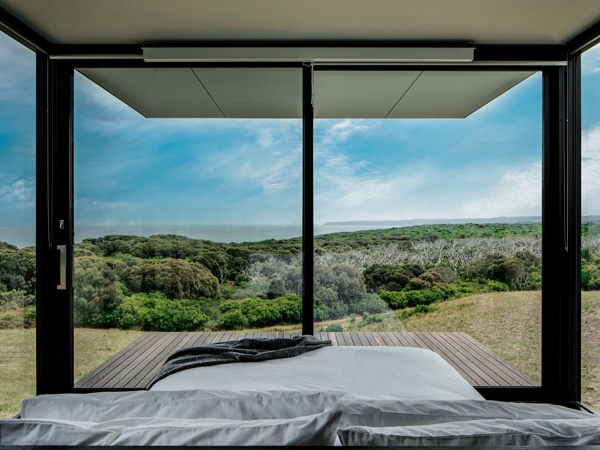
With views like this, sometimes the most show-stopping design is all in the glass-to-wall ratio. (Image: Tofu Studio)
The 80 hectares bordering Great Otway National Park offered sweeping ocean views taking in Moonlight Head and Castle Cove. There was plenty of land to encourage native animals including koalas, kangaroos, echidnas and native birdlife to make their home there. It had an 800-metre walking trail that led to Station Beach, which intercepts the Great Ocean Walk from Apollo Bay to the 12 Apostles, from where you can reach the hidden treasure of Rainbow Falls and see water cascading down cliffs into the ocean.
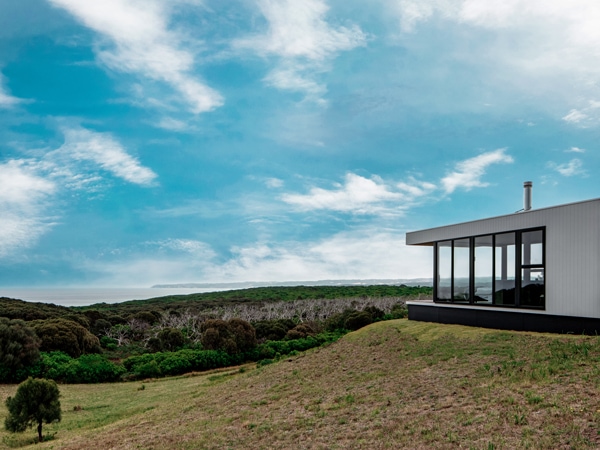
Sky Pods is tucked along the Great Ocean Road at Cape Otway in Victoria. (Image: Tofu Studio)
It also promised sunsets over the ocean nine months of the year. And it was perfect for whale-watching and stargazing. “After completing our project it became evident that this was the perfect property to share with others,” says Maxwell. And so Sky Pods were born. The two pods have been architecturally designed with environmental sustainability at their core, but without compromising on comfort.
Solar-powered and fully off the grid with a minimal carbon footprint, they don’t skimp on mod cons. There’s a fully appointed kitchen, spacious bathroom, wood fireplace and reverse cycle heating and cooling, plus a 2.5-metre projector screen for night-time streaming (when you’re not stargazing). And, with floor-to-ceiling windows that take in the sweeping views the property has to offer from your adjustable bed, it’s clear Sky Pods have got that golden ratio just right.
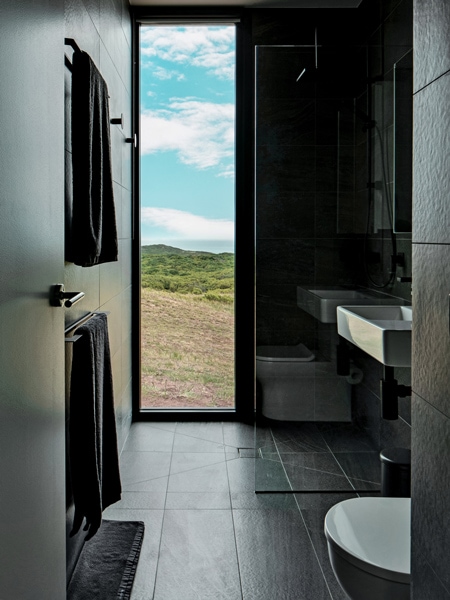
The Sky Pods are solar-powered and fully off the grid with a minimal carbon footprint. (Image: Tofu Studio)
The ‘other side’ of Victoria’s Mornington Peninsula became a weekends-away hotspot to rival its flashy seaside cousins with the opening of Jackalope back in 2017. Surrounded by vineyards, bush and farmland, its arrival in sleepy Merricks North was a shock to the system, given its resolutely modern, high-design visuals and decidedly urban approach.
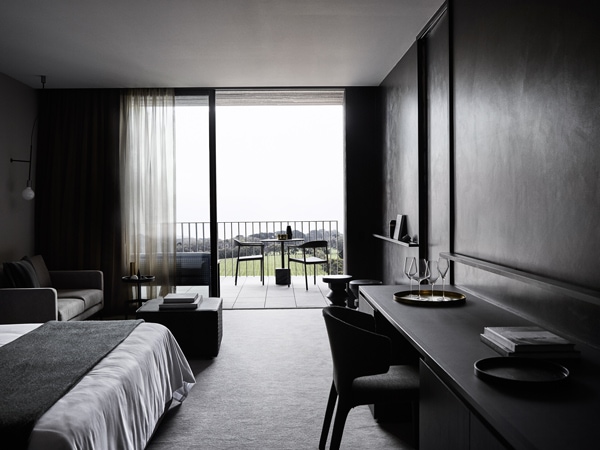
Jackalope is surrounded by vineyards, bush and farmland.
But the melding of city-slick interiors – think muted tones, statement artworks (including Emily Floyd’s Jackalope sculpture at the entrance), designer furniture and lots of mod cons – with bucolic surrounds of neatly planted grapevines and softly undulating taupe and faded green hills has proved an irresistibly unique hook. Visit to lounge by the pool taking in the surrounds, dine at signature eatery Doot Doot Doot, and sample the wares of the on-site winery over a lazy lunch at Rare Hare.
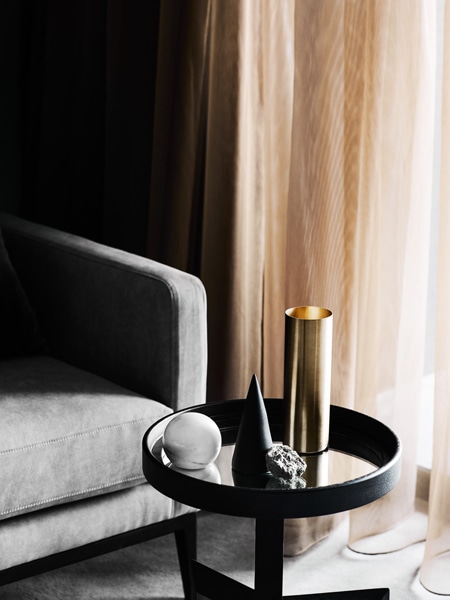
Jackalope’s design perfectly melds city-slick interiors with its bucolic surrounds.
Lon Retreat & Spa has been in the Hanley family for almost 150 years, spanning seven generations. Claire Hanley grew up on the 100-hectare property and, together with her husband, Rob Gemes, transformed the family home into Lon Retreat.
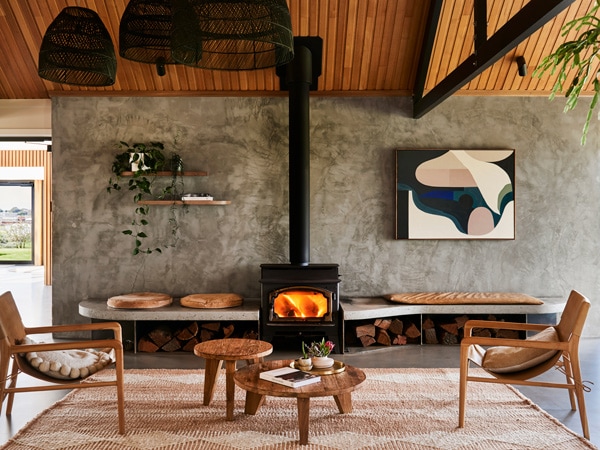
The cosy fireplace inside Lon Retreat is a central feature.
The result is a boutique ‘home hotel’ that comprises seven individually designed suites, a luxurious spa and pool fed by the property’s mineral springs, event spaces and art gallery. And it’s still a family affair. Claire’s parents manage the working farm, which has cattle, a protea plantation and food forest that produces most of the bounty supplied to guests during their stay. Breakfast trays even feature the very popular Lon Honey, available for sale in the Little Shop of Lon, one of many add-ons that surprise and delight.
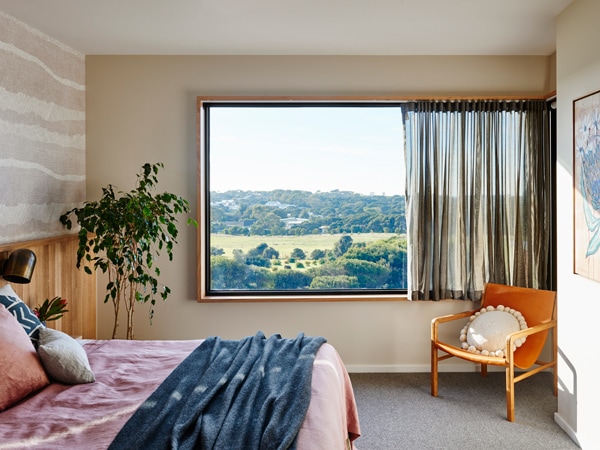
The owners transformed the family home into Lon Retreat.
According to Claire, the vision for Lon, located high on a hill in Point Lonsdale, on the edge of the beautiful Bellarine Peninsula, was to provide a space for people to escape from the hurly-burly of life.
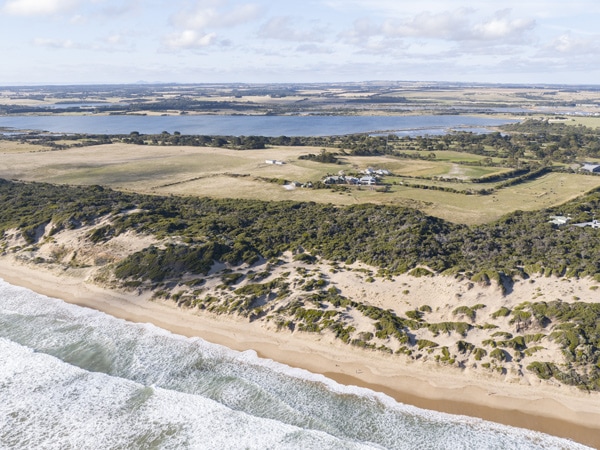
Lon Retreat & Spa is located high on a hill in Point Lonsdale, on the edge of the beautiful Bellarine Peninsula.
What defines the sandstone retreat is that ‘lived-in’ laid-back luxury aesthetic, with timber, natural stone, linen and native flora reflecting a quintessentially Australian landscape. “We want people to find time to watch the clouds change, the weather roll in and the ships pass by. To be in a place where there is luxury without pretentiousness, where you can walk barefoot in your robe from your suite to the spa and simply relax in your own space,” says Claire. The sandstone retreat brings guests in touch with all of these fundamental pleasures and more. – Carla Grossetti
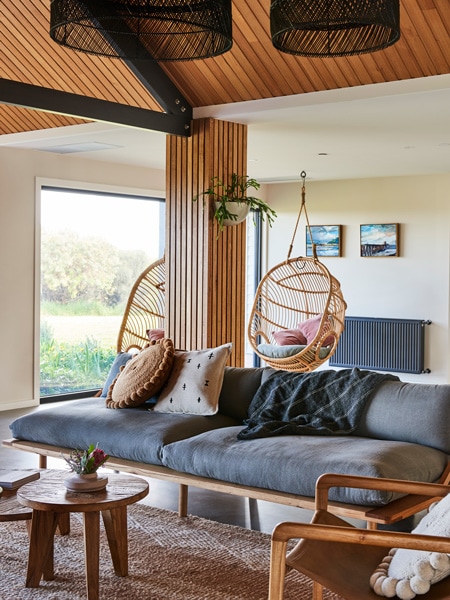
Lon Retreat is defined by that ‘lived-in’ laid-back luxury aesthetic.
When guests first walk into the Paris Villa at Clifftop at Hepburn they are often moved to tears. Nature has never seemed more alluring than when standing in front of the three floor-to-ceiling windows that frame the view of Breakneck Gorge. The organic-shaped hideaway comprises seven stacked shipping containers made of Corten weathering steel, some of which are cantilevered out over the edge of a clifftop overlooking the Elevated Plains. Once inside, everything, from the gentle grain of the reclaimed floorboards, to the soft feel of a French linen throw, or the comforting scent of timber and cowhide leather cries out to be seen, felt and touched.
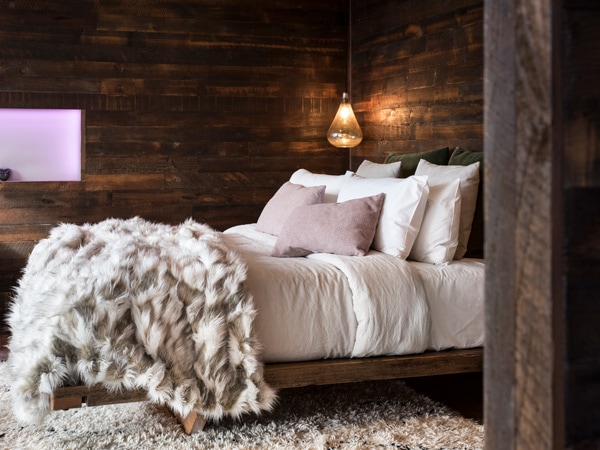
Every texture used within Clifftop at Hepburn is a sensual experience. (Image: Loft Image)
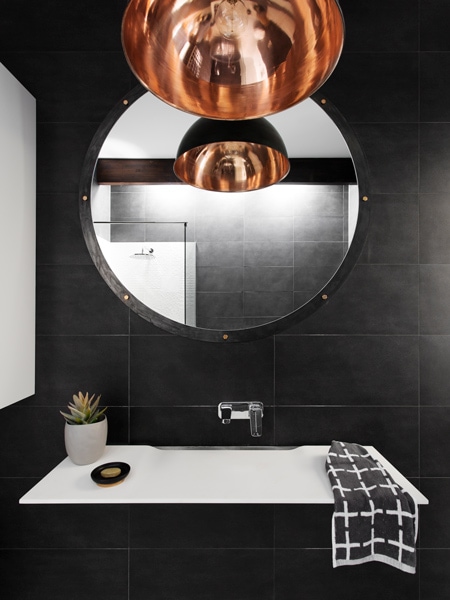
All the comforts of home. (Image: Marina Gemmola)
Owner David Penman says in a world dominated by technology, a haven such as Clifftop at Hepburn demands its guests switch off. Sure, wi-fi is available. But he says he and his wife Manolita’s vision was “to provide everything people don’t have at home and nothing that they do have”. Those ‘extras’ include the world’s best massage chair, a Tasmanian blackwood bath, antique pinball machines, waterfalls that cascade right near to the front door and solar-powered Tesla charging stations. “I’m a big, gruff 6 ft two bloke with a sleeve tattoo and I might hear a song on the radio and start to cry. I relate that back to when people come in and see the view. They’ve read the reviews, they’ve seen the pictures on Instagram and then they walk in and are moved to tears. That makes me know we have got it right,” says David.
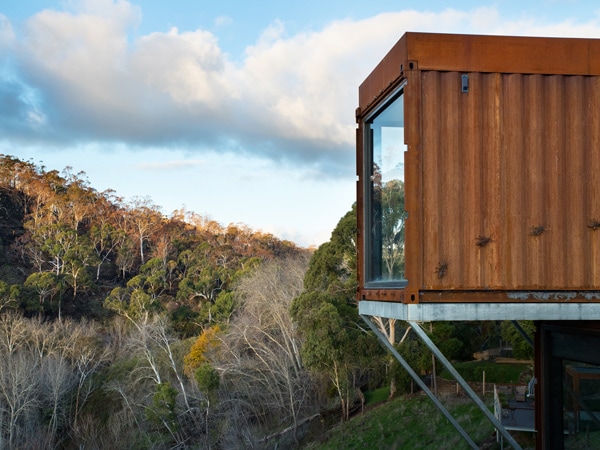
The shipping containers at Clifftop at Hepburn are located close to the attractions of Daylesford. (Image: Loft Image)
“It thrills me to see them step inside these rusted old shipping containers and just stop dead still and stare at the view. It’s all part of the drama. After absorbing the view they move around wanting to touch everything. Every texture is a sensual experience. They run their hands over the hand-woven Moroccan floor rugs, the beautiful fireplace, the recycled hardwood floors and tactile benchtops,” he says.
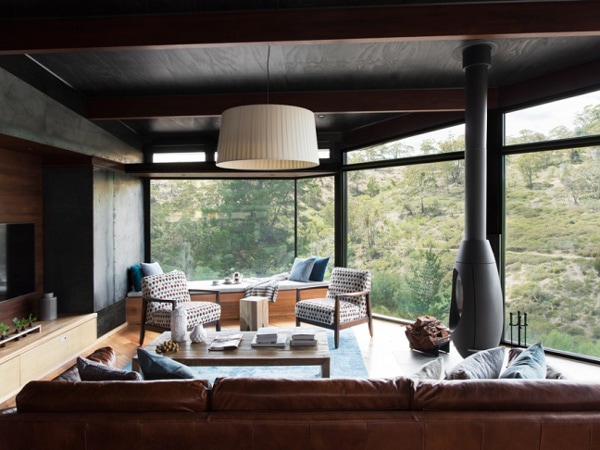
The views are one of the main attractions of a stay at Clifftop at Hepburn. (Image: Marina Gemmola)
The shipping containers at Clifftop at Hepburn are named after four of the world’s romantic cities – Paris, Rome, Vienna and Venice – and regularly rank as one of Australia’s most romantic getaways. But the clifftop villas, located near to natural springs and world-class restaurants in Daylesford, are also family friendly. David says the steel structures also feature a bulletproof glass floor that adds an element of surprise. Principal of Robin Larsen Design, architect Robin Larsen, says when you look at his design of Clifftop at Hepburn from below it resembles a primordial creature crawling across a slope. “It’s organic. It has multiple eyes and a sense of movement. It’s in quite a dramatic location and we have completely capitalised on that,” he says. – Carla Grossetti
LEAVE YOUR COMMENT